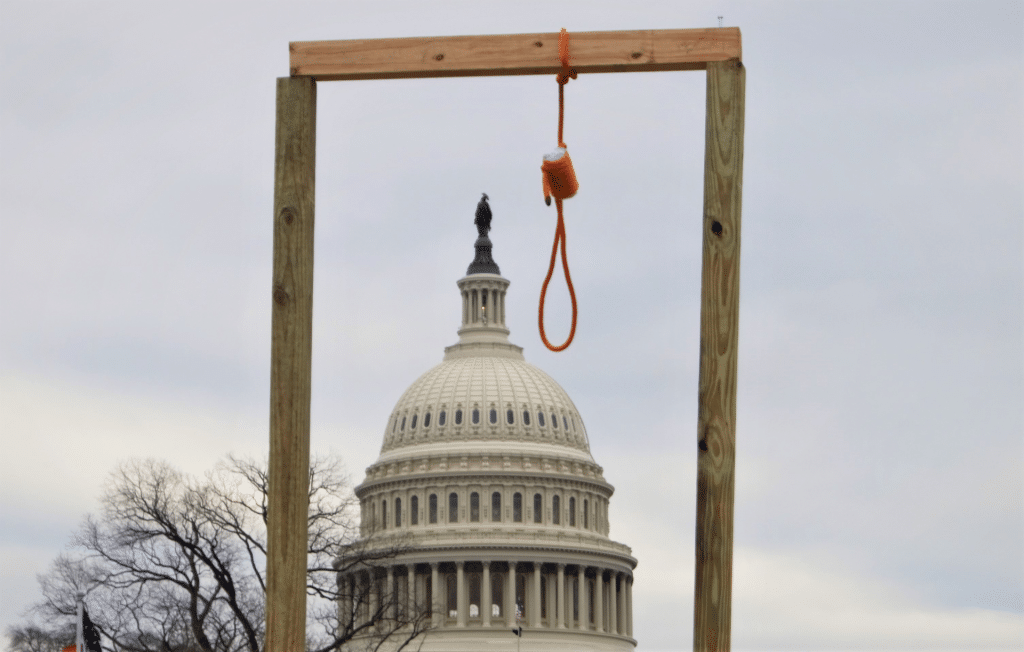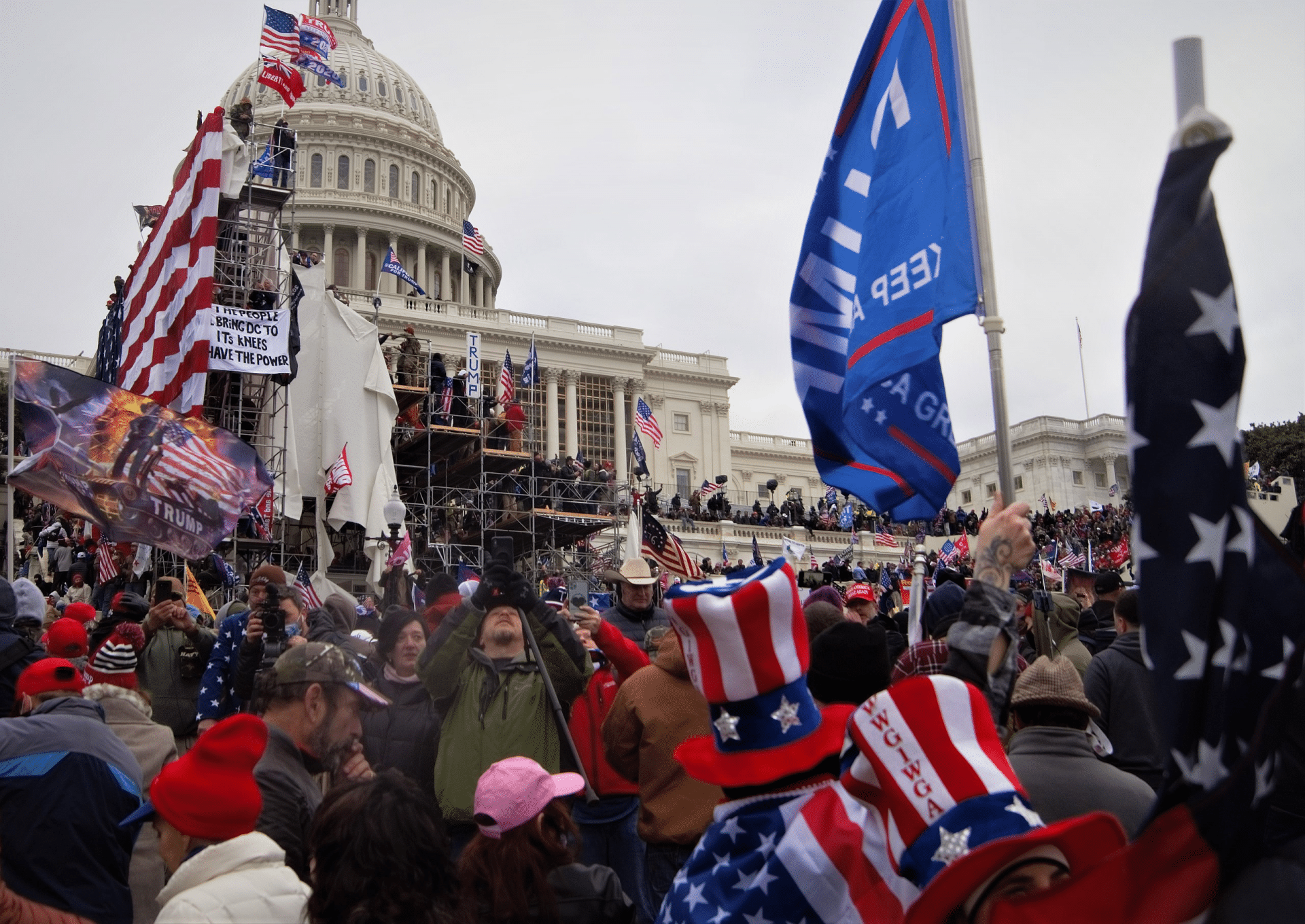After January 6, a new breed of extremism emerges: The mainstream insurrectionist
By Matt Field | January 6, 2022
 A gallows set up outside the US Capitol on January 6, 2021. Credit: Tyler Merbler. CC BY 2.0
A gallows set up outside the US Capitol on January 6, 2021. Credit: Tyler Merbler. CC BY 2.0
Dylann Roof allegedly had a drug problem. He drifted between homes and schools growing up and had quit a landscaping job by the time he killed nine people in a racist attack on a church in Charleston, South Carolina in 2015. Timothy McVeigh, the antigovernment terrorist who killed 168 people when he detonated a bomb in the Oklahoma City federal building in 1995 was a loner and a college dropout. In the past, right-wing extremists have often come from the fringes. But with an estimated 21 million Americans now viewing President Joe Biden as illegitimate and believing violence is justified to restore former President Donald Trump to the White House, support for right-wing extremism is fringe no more, it’s positively mainstream.
The crowd that knocked over barriers, beat back police, and crashed through doors at the US Capitol last January 6, may have numbered around 2,000, but a vast swath of America has its back, according to a new survey by Robert Pape, a political scientist at the University of Chicago, and his team. The tens of millions who Pape’s study estimates support insurrection are heavily influenced both by an idea known as the “great replacement,” which dictates that whites are being replaced by minorities, and the QAnon conspiracy theory. Given its size, the population of insurrection supporters represents a massive risk of more political violence and threats to democracy.
“We’re heading into a 2022 season; it’s a wildfire season where we have a mass of combustible material, dry wood,” Pape said. “Those are the 21 million in the country who have community support for the insurrection, and this mass of dry wood can be touched off by sparks.”
One of the main drivers influencing what Pape’s report terms the “insurrectionist movement” is belief in the great replacement. Seventy-five percent of insurrection supporters agreed that the Democratic Party was trying to reshape the US electorate with “obedient” voters from the Third World.
The idea was once mainly a staple of white supremacists thought. During the infamous 2017 Unite the Right rally at the University of Virginia, for example, demonstrators chanted, “The Jews will not replace us,” and “You will not replace us.” But the great replacement theory has seeped out of the fringe and into mainstream conservative discourse, Pape and other researchers say. In September, for instance, the popular Fox News host Tucker Carlson said (falsely) that Biden supported “the replacement of legacy Americans with more obedient people from far away countries.”
Pape’s poll surveyed 2,000 US adults and, the report says, it represents the “gold standard” of polling methodology with results that can be extrapolated to the general population. Close to 50 percent of the population supportive of insurrection, which the report says represents about 21 million adults, believe in the QAnon conspiracy theory, a diffuse set of beliefs spread on internet message boards and social media platforms that centers on the unhinged idea that a group of Satanist pedophiles is running the US government and that Trump has a plan to right the ship. Pape said belief in QAnon, however, is influenced by whether one believes in the great replacement or not. “Both directly and indirectly, the great replacement is playing a very important role,” he said.

The great replacement, QAnon, and Trump’s so-called Big Lie, that is, that the election was fraught with widespread fraud that allowed Biden to claim the White House, are all false conspiracy theories that have spread widely on social media. Some of Facebook’s own research documents how the platform can guide people to these theories. As part of a test, for example, a researcher employed by the company set up a fake account for a supposedly politically conservative mother. Within days, the platform was recommending the “mother” join QAnon groups. Between Election Day and last January 6, users in Facebook groups were posting an average of more than 10,000 posts a day claiming the election had been illegitimate, with some threatening political violence, according to a Washington Post and ProPublica investigation. Despite this deluge of disinformation, following the election, the company reduced its efforts to stem the problem, according to Facebook whistleblower Frances Haugen.
Of course, the spread of false conspiracy theories is hardly restricted to social media. Pape’s survey found that the most common sources of media for the population that supports insurrection are what Pape deems mainstream conservative television stations like Fox News or Newsmax.
In addition to looking at the population of community supporters of insurrection, Pape also studied the background of 654 people arrested for their actions at the Capitol last year. The two studies are complimentary, he said. Many of the arrested came from counties losing white population; the greater a county’s decline was, the higher the chance of the county sending an insurrectionist to the Capitol last year was.
Just as the estimated 21 million people who view Biden as illegitimate and support violence to restore Trump to the White House can’t be categorized as fringe, neither can the insurrectionists at the Capitol last year. About 50 percent of the people Pape looked at were business owners or white-collar professionals, including lawyers, doctors, and architects. One worked for Google; another ran a marketing company.
“These are folks who are experiencing and seeing demographic change in their area. And they’re also being exposed to this right-wing theory called the great replacement by political leaders they follow, by media people they follow, and so [it didn’t come] as a huge surprise to us that a portion of those mainstream followers are starting to embrace those ideas and become angered by them,” Pape said.
The images of January 6—the smoke rising from the Capitol, the throngs of Trump supporters hanging off of balconies and platforms, the security officers aiming guns at the barricaded House chamber doors, wondering how soon they would be breached, and the brazenness of Trump actually pushing, until the last moments, to get lawmakers and former Vice President Mike Pence to overturn the election by not certifying the electoral college results—seemed at the time to leave an indelible stain. Even some of Trump’s most voluble backers in the Republican Party denounced what had happened.
“Trump and I, we’ve had a helluva journey,” Lindsey Graham, the South Carolina Republican senator and staunch Trump supporter, said. “I hate it to end this way. Oh my god I hate it… Count me out. Enough is enough.”
But as time passed, those views softened as Trump and his supporters tried in a variety of ways to rewrite the reality of the event. And Trump, who’s still repeating the lie that the 2020 election was stolen from him, could be the Republican front-runner in the 2024 presidential contest. Pape said that some factors that could have been expected to reduce the appetite the public has for another January 6-type event haven’t had an effect. Despite months having passed, despite hundreds of arrests, despite Trump having lost access to Twitter and Facebook, the size of the insurrectionist movement—people who believe violence is justified in restoring Trump to office and that Biden is an illegitimate president—did not change between June and September, according to Pape’s research.
“We are facing the most strenuous test of our democracy in our lifetime,” Pape said “The number one thing we have to do is diagnose what’s really going on. We’ve learned quite a bit about what’s going on, and now we have to have dialogue about the new empirical reality.”
Together, we make the world safer.
The Bulletin elevates expert voices above the noise. But as an independent nonprofit organization, our operations depend on the support of readers like you. Help us continue to deliver quality journalism that holds leaders accountable. Your support of our work at any level is important. In return, we promise our coverage will be understandable, influential, vigilant, solution-oriented, and fair-minded. Together we can make a difference.
Keywords: January 6, capitol siege, conspiracy theories, insurrection, qanon
Topics: Disruptive Technologies















Those polls are measuring symptoms, not the problem. The top 20% have done a very good job of destroying the American Dream for the bottom 60%. Until that stops–big problems. The bottom 60% found inflation adjusted incomes drop by about 15% thanks to (1) the Mexico trade deal and China trade deal that destroyed millions of high paying non-college-educated jobs and effectively destroyed the industrial union movement in the U.S. and (2) massive low-skill legal and illegal immigration. More than 90% of the money in the financial bail-out of Wall Street went to the top 10% and nobody went to… Read more »